ABNC issues of Infalsificables
To hinder counterfeiting all denominations have backgrounds in various colors printed in geometric patterns (imaginatively called “machina loca” in the contract in Spanish), microprinted texts with “Constitución y Reformas”, the motto of the Carrancista movement, different rosettes and the denomination in different fonts and sizes in the four corners. The serial number is printed twice on all denominations in red, except on the 20 pesos where it is in blue to improve the contrast with the background. Unlike the notes printed in Mexico these do not have a date of issue.
On the back, all are printed in intaglio in a single color, with the respective denomination and a vignette in the center of the Piedra del Sol or Aztec Calendar (C-759), engraved in 1900 especially for the $500 banknote of the Banco Occidental de México by Edwin H. Gunn and Charles Skinner. This had been proposed for the reverse of the unissued 50c notes of the Banco Oriental de México in 1914, of the Banco de la República Mexicana in 1918, and finally used in these infalsificables and in the very famous one peso banknote of the Banco de México between 1935 and 1970.
On the reverse, they also have the seal of the Ministry of Finance. Although normally these seals were applied in Mexico and the newspaper El Pueblo indicated that the notes would be sealed and counterstamped by the Stamp Printing Office“El día 12 del mes entrante estarán ya resellados y contraseñados los billetes de la nueva emisión”, El Pueblo, Año III, Tomo I, Núm. 521, 1 April 1916, just as those of the banks of issue, the text of the contract and the appearance of specimens with this characteristic, prove that they were requested and delivered completely finished from New York and perhaps this was due to the presence of a Carrancista representative, such as Ortiz Rubio, during the printing process. All the notes have the traditional imprint with the name of the company on the front and back.
$5
On the face of the $5 note appears a vignette engraved by Charles Skinner of the monument to Cuauhtémoc, designed by Francisco M. Jiménez in 1887 and located on the current Paseo de la Reforma in Mexico City. This vignette was commissioned in 1899 especially for the reverse of the one and two peso certificates of deposit of the Banco Internacional Hipotecario de México and was classified as C-376 in the ABNC fileThanks to Mark Tomasko for his help in identifying the numbers and engravers of the vignettes.. The same monument, but from a different angle, adorns the $1,000 note of the Banco Occidental de México.
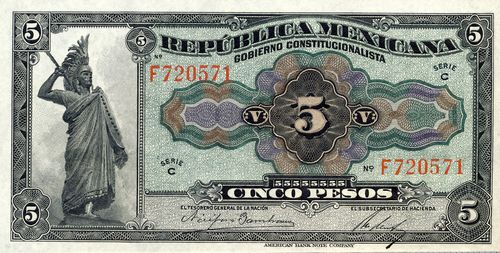
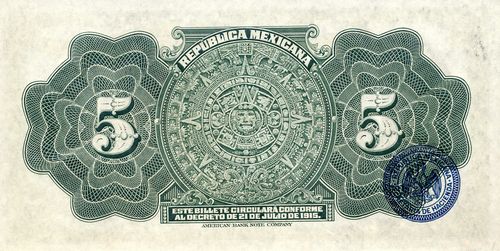
| Date of issue | Date on note | Series | from | to | Tesorero General | Subsecretario de Hacienda |
comment |
| C | 000001 | 1000000 | Zambrano | Nieto | |||
| A 000001 | A1000000 | ||||||
| B 000001 | B1000000 | ||||||
| C 000001 | C1000000 | ||||||
| D 000001 | D1000000 | ||||||
| E 000001 | E1000000 | ||||||
| F 000001 | F1000000 | ||||||
| G 000001 | G1000000 | ||||||
| H 000001 | H1000000 | ||||||
| J 000001 | J1000000 | ||||||
| K 000001 | K1000000 | ||||||
| L 000001 | L1000000 | ||||||
| M 000001 | M1000000 | ||||||
| N 000001 | N1000000 | ||||||
| P 000001 | P1000000 | ||||||
| Q 000001 | Q 400000 | consigned to Laredo | |||||
| Q 400001 | Q 450000 | consigned to Nogales | |||||
| Q 450001 | Q 500000 | consigned to El Paso | |||||
| Q 500001 | Q1000000 | consigned to Laredo | |||||
| R 000001 | R 300000 | ||||||
| R 300001 | R 400000 | consigned to Nogales | |||||
| R 400001 | R 500000 | consigned to El Paso | |||||
| R 500001 | R1000000 | ||||||
| S 000001 | S1000000 | ||||||
| T 000001 | T 500000 | consigned to Laredo | |||||
| T 500001 | T 750000 | consigned to Nogales | |||||
| T 750001 | T1000000 | consigned to El Paso | |||||
| U 000001 | U1000000 | ||||||
| V 000001 | V 500000 | ||||||
| V 500001 | V1000000 | consigned to Laredo | |||||
| W 000001 | W 250000 | consigned to Nogales | |||||
| W 250001 | W 500000 | consigned to El Paso | |||||
| W 500001 | W1000000 | ||||||
| X 000001 | X1000000 | ||||||
| Y 000001 | Y 600000 | ||||||
| Y 600001 | Y1000000 | consigned to Laredo |
|||||
| Z 000001 | Z 300000 | ||||||
| Z 300001 | Z 650000 | consigned to El Paso | |||||
| Z 650001 | Z1000000 | consigned to Nogales |
$10
A bust of Generalissimo José María Morelos, engraved by Robert Savage in 1915 specifically for this note, illustrates the ten pesos (C-423) At this time, the portraits had a different numeration to the vignettes, although they also began with the letter C.
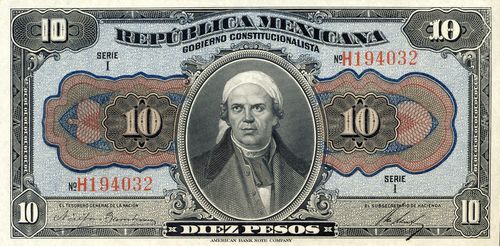
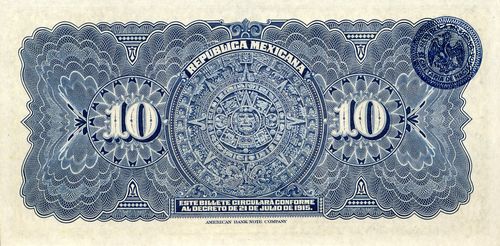
| Date of issue | Date on note | Series | from | to | Tesorero General | Subsecretario de Hacienda |
comment |
| I | 000001 | 1000000 | Zambrano | Nieto | |||
| A 000001 | A1000000 | ||||||
| B 000001 | B1000000 | ||||||
| C 000001 | C1000000 | ||||||
| D 000001 | D1000000 | ||||||
| E 000001 | E1000000 | ||||||
| F 000001 | F1000000 | ||||||
| G 000001 | G 500000 | ||||||
| G 500001 | G 900000 | consigned to Laredo | |||||
| G 900001 | G 950000 | consigned to Nogales | |||||
| G 950001 | G1000000 | consigned to El Paso | |||||
| H 000001 | H 800000 | consigned to Laredo | |||||
| H 800001 | H 900000 | consigned to Nogales | |||||
| H 900001 | H1000000 | consigned to El Paso | |||||
| J 000001 | J1000000 | ||||||
| K 000001 | K 200000 | ||||||
| K 200001 | K 600000 | consigned to Laredo | |||||
| K 600001 | K 800000 | consigned to Nogales | |||||
| K 800001 | K1000000 | consigned to El Paso | |||||
| L 000001 | L 600000 | ||||||
| L 600001 | L 800000 | consigned to Laredo | |||||
| L 800001 | L 900000 | consigned to Nogales | |||||
| L 900001 | L1000000 | consigned to El Paso | |||||
| M 000001 | M 300000 | ||||||
| M 300001 | M 400000 | consigned to Laredo | |||||
| M 400001 | M 450000 | consigned to El Paso | |||||
| M 450001 | M 500000 | consigned to Nogles |
$20
The twenty pesos show the seated statue of former president Benito Juárez, franked by two allegorical figures representing Patria and justice, engraved by William Adolph (C-1458). The statue is similar to the one made by the Italian sculptor Lanzaroni for the hemicycle to this hero built in 1910 and located in the Alameda Central of the capital.
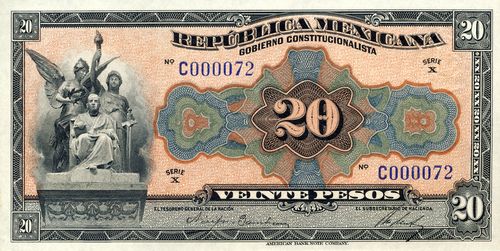
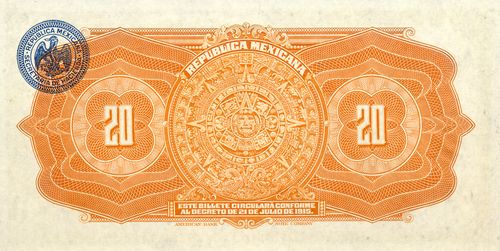
| Date of issue | Date on note | Series | from | to | Tesorero General | Subsecretario de Hacienda |
comment |
| X | 000001 | 1000000 | Zambrano | Nieto | |||
| A 000001 | A1000000 | ||||||
| B 000001 | B1000000 | ||||||
| C 000001 | C1000000 |
$50
An engraving made by William J. Brown of the baroque style cloister of the ex-convent of San Agustín in Querétaro (C-1459), built in the 18th century, which served as a barracks, hospital, Government Palace and is currently the headquarters of the Art Museum of that city, is illustrated on the fifty pesos. This was re-engraved by Harold Osborn in the middle of the thirties for the reverse side of the $20 note of the Banco de Mexico (V-76830).
In the interview that Undersecretary Nieto gave to El Pueblo on 25 July 1915El Pueblo, Año II, Tomo II, Núm. 352, 25 July 1915 he mentioned, among the intended designs, the Faros at Veracruz. This was the headquarters of the Provisional Government and residence of Carranza while the capital was established in that port, bur Carranza later moved to the Federal Palace in Querétaro, where the he had his office months later and during the Constituent Assembly.
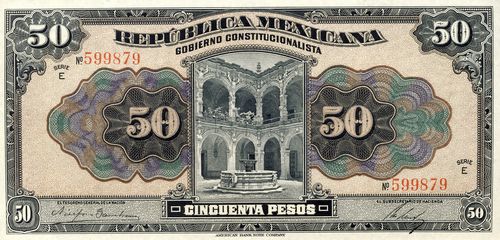
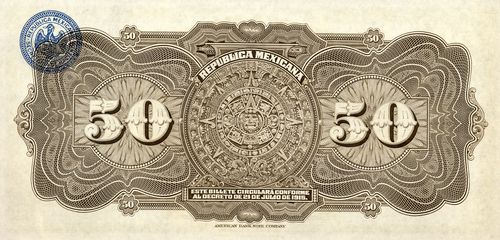
| Date of issue | Date on note | Series | from | to | Tesorero General | Subsecretario de Hacienda |
comment |
| E | 000001 | 1000000 | Zambrano | Nieto | |||
| A 000001 | A 300000 |
$100
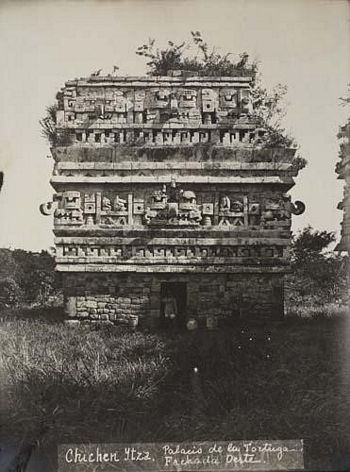
The $100 note has an engraving by Edwin Gunn of a Mayan building located in Chichen ltza, a mixture of Puuc and Chenes styles, known as “la iglesia (the church)” (C-1455), although it appears as “the west façade of the Palacio de the Turtle” in a photograph from the time of Charles B. Waite, which could have been used as a model for this engraving. In 1919, in response to a query, the Engraving Department noted that the original photograph was entitled "T. Tartuga Carcaol F. Oests (sic)"ABNC, folder CB #36, print records.
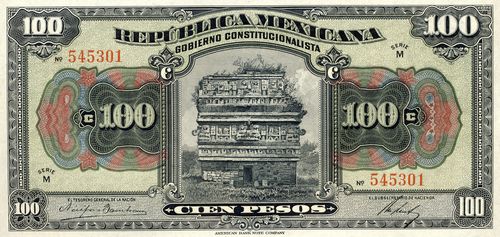
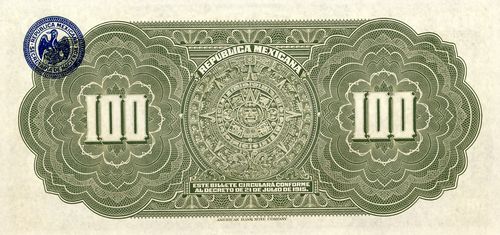
| Date of issue | Date on note | Series | from | to | Tesorero General | Subsecretario de Hacienda |
comment |
| M | 000001 | 650000 | Zambrano | Nieto |
